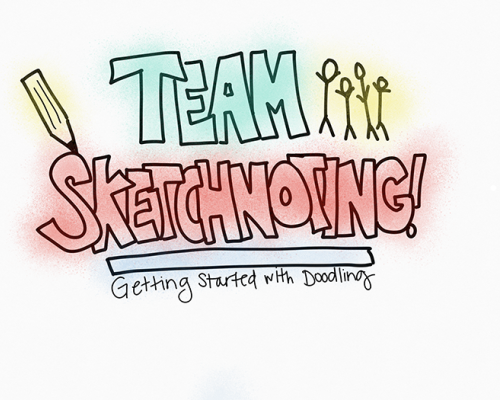Sketchnoting, Doodling, and Visual Note-Taking
Date
Thanks to Sunni Brown’s presentation at IntegratED PDX earlier this year, I was able to host a visual note-taking “jam session” with my team. Though some of us started with apprehension (“I can’t draw!”), I think we ended a lot more confident—or at least tickled—than we were when we started.
What are Sketchnotes?
Some of my colleagues voiced that the sketchnotes they’d seen were beautiful, frame-worthy works of art , but fret not—sketchnotes come in all shapes and sizes! Sketchnoting is like social media: you can use it religiously in order to brand yourself, or you can be a casual Facebooker who just uses it to keep up with friends and family. Mike Rohde , the author of The Sketchnote Handbook, says simply that “Sketchnotes are rich visual notes created from a mix of handwriting, drawings, hand-drawn typography, shapes, and visual elements like arrows, boxes, and lines.”
So, if all those things are items on a shelf, they don’t all have to end up in your grocery cart! You may just be a sketch-noter who uses boxes, brackets, and the occasional arrow.
Why Sketch?
First we must ask: why take notes? Answer: in order to process and remember information. Okay, so why sketch those notes? In her TEDTalk , Sunni Brown explains that we have to be able to distill and synthesize material in order to sketchnote it. We have to be able to understand the relationship between concepts, and it’s not always linear—so drawing is required! One of my favorite quotes from Sunni’s TEDTalk is, “We think doodling is something you do when you lose focus, but in reality, it is a pre-emptive measure to stop you from losing focus.”
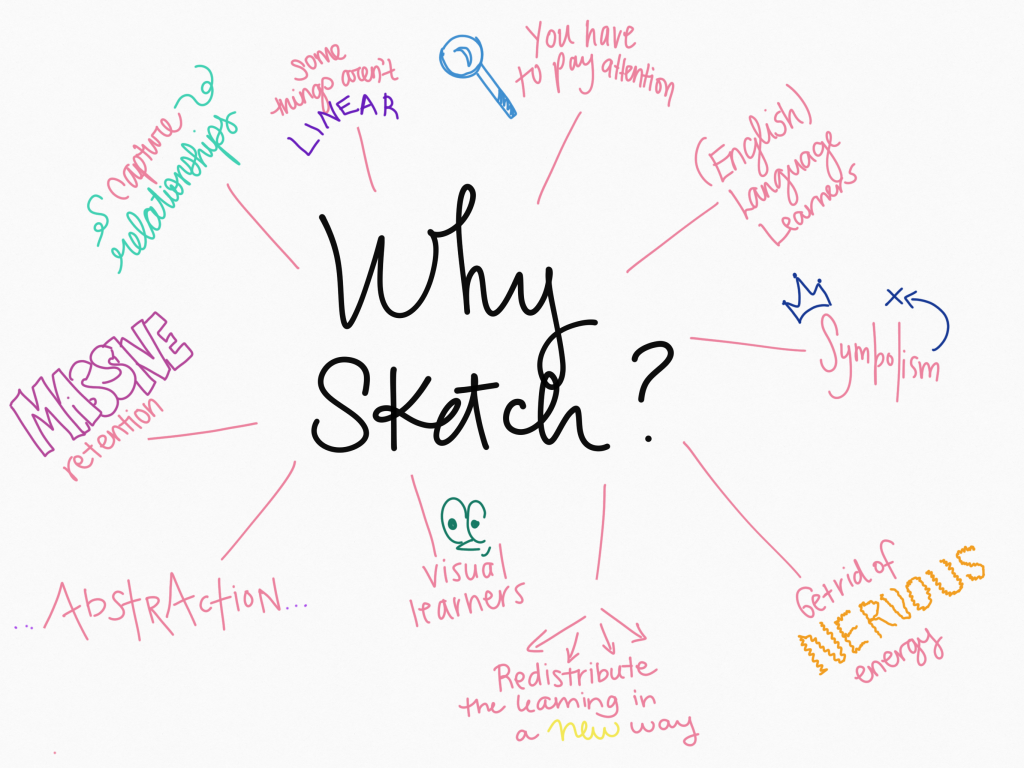
More reasons to Sketch
(I drew this image using a free sketching iOS app, Tayasui Sketches )
Helpful questions that came out of the session:
Is doodling the same as sketchnoting?
There is obviously some difference between drawing shapes in the margins that may not pertain to what is being discussed, and sketching conceptual connections to the current conversation. However, what’s important to consider is that people who are “doodling” may be sketchnoting, and even if not, it’s not necessarily that they are not paying attention—doodling may be their “preventive” measure to stay tuned-in!
Do I do all of this beautiful sketchnoting while the meeting/speaker/lecture is occurring or do I go back and do it?
Sketchnoting is whatever you make of it! Some sketch-noters take verbal notes and go back through to sketchnote them, making sure they’re reviewing important concepts and making connections they may not have captured in the session. Others may be sketchnoting on the fly, and their notes will look a bit different than the polished, perfected sketchnotes of social media. And some people do both! It is whatever brings value to you that matters.
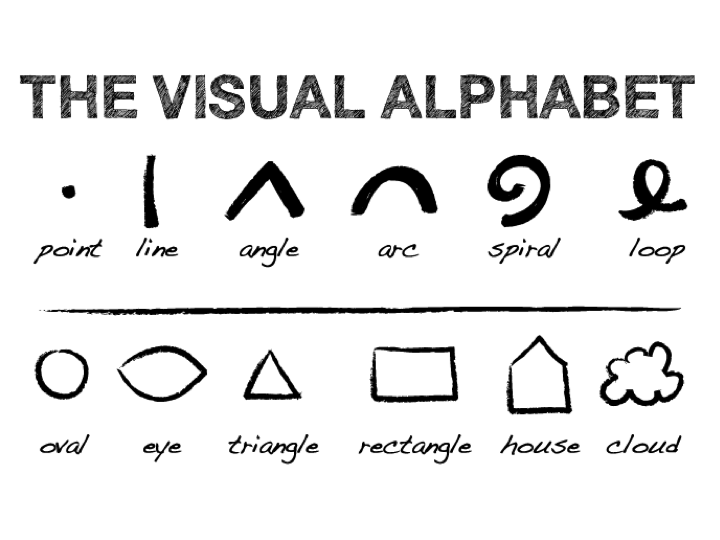
Group activities we engaged in using the Visual Alphabet:
Draw your own Visual Alphabet. Whether you’re copying the one above or adding to it, practice these basic shapes and remind yourself that that’s all there is to it!
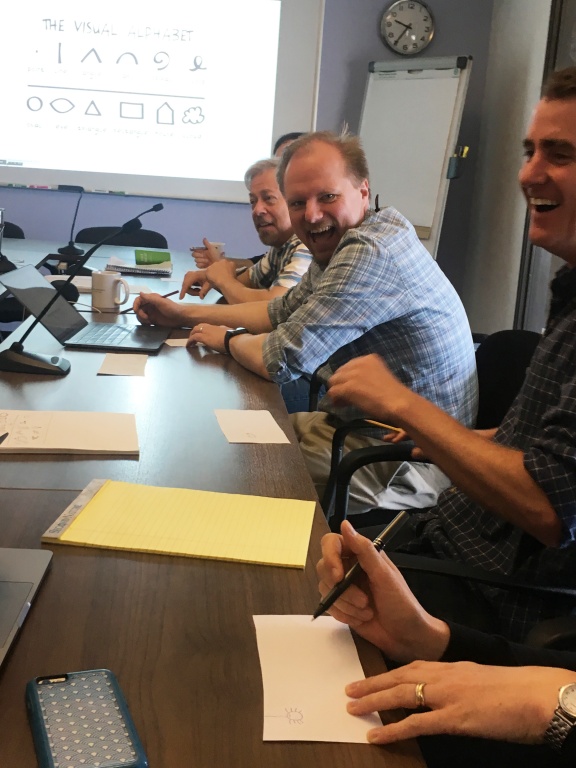
Dale, Thor, and Tod having fun sketch-noting!
15 Second Draw. I called out various images—”cheese,” “coffee,” “hat,” “camera,” and “tornado”—and participants only had 15 seconds to draw it on their personal piece of paper. This serves to loosen people up and show them that they really can draw! When we drew our last prompt, a light bulb, we discussed that this could be a recurring motif in sketchnoting when you want to capture an idea you had during a meeting or a class.
Draw-Pass. As participants sat around a table, they each got a new piece of clean paper and were given 25 seconds to draw an image. After 25 seconds, they passed the paper to their right, and were given 25 seconds to draw a new image. This ensures that everyone is seeing what others are doing, and that sometimes we’re comfortable drawing something, and sometimes we struggle! It also helps to get ideas from other drawers, and to see that we all make similar associations when drawing. These image prompts were a little more challenging, with words like “spider,” “whisper,” “camping,” “compromise,” “violin,” and “remember.”
Giant Post-It Group Draw. Participants were divided into teams of four, grouped around a giant notepad, and given a single group marker. Each round consisted of 25 seconds, and one participant drew at a time. You were allowed to help your group, but you couldn’t take the marker away from the drawer’s hand until it was your turn. These words were a bit of a grab-bag, like, “mango,” “sticky,” “scattered,” “teamwork,” “margarita,” “climb,” and “interrupt.”
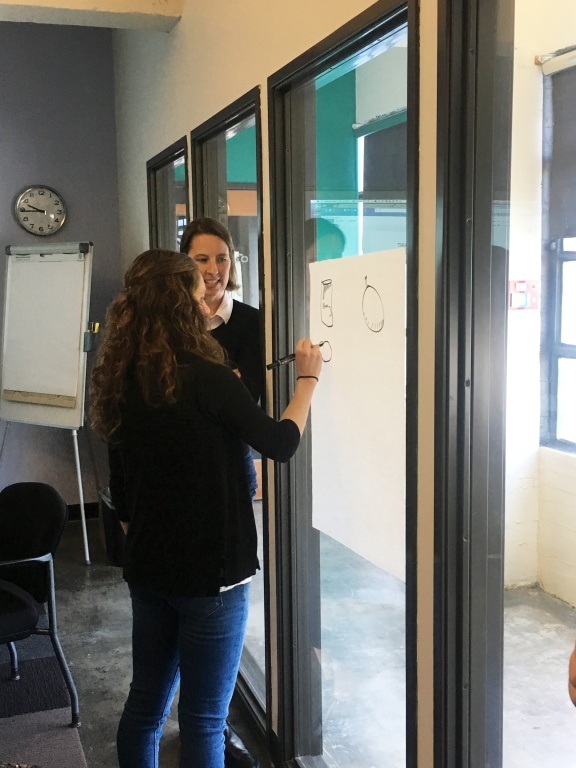
Laura talks Allison through drawing “teamwork”
These activities were so much fun, both for loosening-up our drawing skills and for team building. As we kept drawing, doodlers appeared more confident, and the time constraints allowed for general sketching rather than the pressure to create a masterpiece.
We wrapped up the session with ideas for sketchnoting our thoughts during meetings, and requests for colored pencils in our conference room!
Some additional resources:
- Another TEDTalk by Rachel Smith, who “pays attention” for a living—and draws it!
- This study in Psychological Science that explores the advantages of writing rather than typing
- Making Learning Visible: Doodling Helps Memories Stick
- Derek Bruff’s Teaching and Learning Blog: Why Use Sketchnotes in the Classroom ?
- This exhaustive list of Sketchnoting in Education resources from Kathy Schrock’s Guide to Everything
